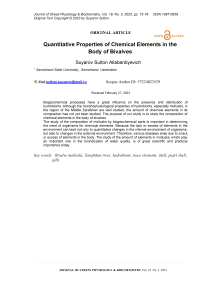Quantitative properties of chemical elements in the body of bivalves
Автор: Suyarov S.A.
Журнал: Журнал стресс-физиологии и биохимии @jspb
Статья в выпуске: 3 т.19, 2023 года.
Бесплатный доступ
Biogeochemical processes have a great influence on the presence and distribution of hydrobionts. Although the morphophysiological properties of hydrobionts, especially mollusks, in the region of the Middle Zarafshan are well studied, the amount of chemical elements in its composition has not yet been studied. The purpose of our study is to study the composition of chemical elements in the body of bivalves. The study of the composition of mollusks by biogeochemical parts is important in determining the need of organisms for chemical elements. Because the lack or excess of elements in the environment can lead not only to quantitative changes in the internal environment of organisms, but also to changes in the external environment. Therefore, various diseases arise due to a lack or excess of elements in the body. The study of the amount of elements in mollusks, which play an important role in the bioindication of water quality, is of great scientific and practical importance today.
Bivalve mollusks, zarafshan river, hydrobiont, trace elements, shell, pearl shell, gills
Короткий адрес: https://sciup.org/143180575
IDR: 143180575
Список литературы Quantitative properties of chemical elements in the body of bivalves
- Bgatov A.V. (1999). Biogenic classification of chemical elements. Filosofiya nauki [Philosophy of science]. No 2 (6). P. 23-34 (in Russ.)
- Boymurodov, K., & Khasanov, N. (2021). Influence of abiotic factors on biodiversity of the populations of bivalve molluscs of the Lower Zarafshan reservoirs. In E3S Web of Conferences (Vol. 265, p. 01012). EDP Sciences.
- Eisler, R. (1989). Molybdenum hazards to fish, wildlife, and invertebrates: a synoptic review (No. 19). Fish and Wildlife Service, US Department of the Interior. Ermakov, V.V. (2017). AP Vinogradov’s concept of biogeochemical provinces and its development. Geochemistry International, 55, 872-886.
- Golovanova I.L. (2008). Effect of Heavy Metals on Physiological and Biochemical Status of Fishes and Aquatic Invertebrates. Inland Water Biology. (1). 99-108.
- Janz D.M. (2012).Selenium in Homeostasis and Toxicology of Essential Metals. Fish Physiology. 314. 327-374.
- Kovalsky V.V. (1982).Geochemical environment and life M.: Nauka, 76 p.
- Kovalsky V.V. (2009) Problems of biogeochemistry of microelements and geochemical ecology. Election Tr. M.: Rosselkhozakademiya, 357 p.
- Kurskov S.N., Rastegaev O.Yu. (2013). Selenium in natural water. Finding optimal concentrations. Theoretical and applied ecology, 3. 70–75
- Lakin G.F. (1990). Biometrics. M.: Higher school, 370 p.
- Martynova M.V. (2012). Manganese occurrence forms, their content and transformation in freshwater sediments. Ecological chemistry. 21(1). 38-52.
- Moiseenko, T.I., & Gashkina, N.A. (2007). The distribution of trace elements in surface continental waters and the character of their migration in water. Water Resources, 34, 423-437.
- Moiseenko, T.I., Gashkina, N.A., Sharova, Y.N., & Kudryavtseva, L.P. (2008). Ecotoxicological assessment of water quality and ecosystem health: A case study of the Volga River. Ecotoxicology and Environmental Safety, 71(3), 837-850.
- Moiseenko, T.I., Kudryavtseva, L.P., & Gashkina, N.A. (2005). Assessment of the geochemical background and anthropogenic load by bioaccumulation of microelements in fish. Water Resources, 32, 640-652.
- Moiseenko, T.I., Voinov, A.A., Megorsky, V.V., Gashkina, N.A., Kudriavtseva, L.P., Vandish, O.I., ... & Koroleva, I.N. (2006). Ecosystem and human health assessment to define environmental management strategies: the case of long-term human impacts on an Arctic lake. Science of the total environment, 369(1-3), 1-20.
- Moore, J.W., & Ramamoorthy, S. (2012). Heavy metals in natural waters: applied monitoring and impact assessment. Springer Science & Business Media. Plokhinsky N.A. (1982). Biometric analysis in biology. M.: Publishing house of Moscow State University, 157 p.
- Saiki, M.K., Jennings, M.R., & Brumbaugh, W.G. (1993). Boron, molybdenum, and selenium in aquatic food chains from the lower San Joaquin River and its tributaries, California. Archives of environmental contamination and toxicology, 24, 307-319.
- Sharma J., Behera P.K. (2021) Potential Of Macro-Invertebrates In Bioaccumulation Of Heavy Metals – A Review. Asian Jr. of Microbiol. Biotech. Env. Sc. Vol. 23, No. (3) 446-451
- Shilova N.A., Rogacheva S.M., Linnik M.V. (2012) Influence of EMR EHF on the resistance of hydrobionts to salts of heavy metals. Proceedings of the Samara Scientific Center of the Russian Academy of Sciences. 14 (5(3)). 863 - 865.
- Simonsen, L.O., Harbak, H., & Bennekou, P. (2012). Cobalt metabolism and toxicology—a brief update. Science of the Total Environment, 432, 210-215.
- Türkmen, A., Türkmen, M., Tepe, Y., & Akyurt, İ. (2005). Heavy metals in three commercially valuable fish species from Iskenderun Bay, Northern East Mediterranean Sea, Turkey. Food Chemistry, 91(1), 167-172.
- Veltman, K., Huijbregts, M. A., Kolck, M. V., Wang, W. X., & Hendriks, A. J. (2008). Metal bioaccumulation in aquatic species: quantification of uptake and elimination rate constants using physicochemical properties of metals and physiological characteristics of species. Environmental science & technology, 42(3), 852-858.
- Vernadsky V.I. (1987). Living substance: monograph. M.: Science. 287 p.
- Vladimirova M.G., Semenenko V.E. (1962) Intensive culture of unicellular algae. Moscow: Publishing House of the Academy of Sciences of the USSR. 59 p.


